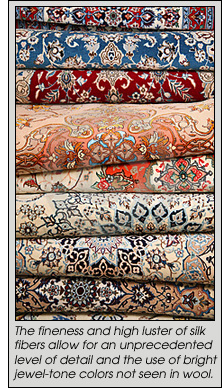F.A.Q.
Hagopian University. You have questions? We have answers!
Rug FAQ’s
HINT: Watch out for rugs sold to tourists, "going out of business sales," so-called estate sales and itinerant auctions. These types of businesses generally sell the rugs that reputable retailers pass on because of quality. They buy low and sell high hoping that you will not do your research because you are pressured by their artificial time lines! Take your time and buy a quality rug that you can love the rest of your life.
 ~Wool Quality
~Wool Quality Since most oriental rugs are made from wool, the quality of the wool is the most critical element of the rug's overall quality and in turn it's durability and soil-resistance. Good wool will have a natural luster; bad wool is dry and brittle. For more information regarding wool see our wool reference page The Wonder of Wool!
~ Knot Count
It takes a skilled weaver to produce a high knot count rug. Usually, better grades of wool and silk are used in high knot count rugs. Conversely, some of the most beautiful and expensive rugs in the world have low knot counts. While it tells you a lot about the density of a rug and can affect the price and durability, the knot count, or line count should not be the only factor in deciding whether or not you buy a certain rug. There are no minimum standards for knot counts. It's more important that you like the rug rather than worry about whether or not it has the right number of knots per square inch.
Years of selling rugs by pushing the importance of knot count over all other quality indicators have left many rug shoppers with an incomplete picture. A simple analogy is to think about rugs as you would art - no one would ever value a painting by simply counting the brush strokes! Using knot count alone to judge quality is a gross oversimplification of a wonderfully complex hand made art form.

Many rugs are made with symmetrical designs, therefore when judging the quality look out for designs that are significantly stretched or compressed in a manor that detracts from the symmetry. Although some imperfections are part of the natural beauty, significant imperfections will reduce the value. Rugs generally fall into three production types: city, village, or tribal. "City" rugs, which are rugs made in large weaving centers, should have very few imperfections and should be judged on the consistency of their designs, weave, and materials. With "village" rugs imperfections are an important part of the charm where the weavers personality can be expressed through their work. Still even with village production poor weaving and material quality should not be confused with charming design imperfections. And finally, "tribal" rugs are woven by nomads, a group of people whose lifestyle is fast disappearing as modern society restricts their seasonal movement. These rugs are generally small and made completely of wool (warp, weft and pile) since it is the only fiber easily available to the weavers.
~ Dyes and Abrash
Many rugs today are made with quality synthetic and natural dyes that are colorfast. If you are buying a rug and you see that in some areas the design has a blurred outline, then it could be that the dyes are unstable and will run when it is cleaned. One way to check for dye run problems is to rub the rug with a damp white cloth using warm water. If the color comes off on the cloth, then the dye will most likely run when the rug is cleaned. Our advice is to avoid rugs that show signs of dye run, unless of course you really love the piece.
With city rugs, abrash (see glossary) is not beneficial and will most definitely reduce the value. On the other hand, with village rugs, abrash can enhance the beauty and its folk art appeal.
- Design Concept
- Raising Sheep
- Shearing Wool
- Separating various colors of natural wool
- Carding wool
- Washing Wool
- Spinning Wool
- Dyeing Wool – to match desired colors in design
- Graphing the design
- Setting up the loom with cotton, wool or silk warp
- Weaving begins
- When rug is finished, cut off loom (can be 4 – 24 months)
- Washing finished rug
- Lay flat to dry
- Shearing
- Finishing the fringes and edges so rug will not unravel
- Transporting to Market